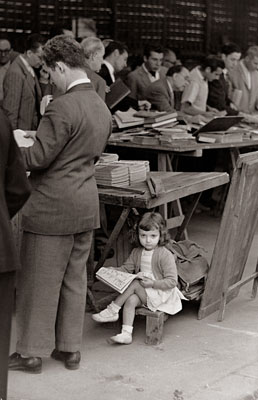Недальновидность?..
С точки зрения читателя,
журнал "Советское фото", №8, 1987 год
Более десяти лет я работал в профессиональной фотографии, выпустил несколько фотоальбомов. Мне хотелось бы поддержать попытки журнала воздействовать на фотопромышленность с целью улучшить качество фотоаппаратуры.
В № 11 "СФ" за 1986 год помещено очередное разъяснение заместителя начальника Центральной рекламно-коммерческой организации "Рассвет" тов. Федина о причинах прекращения выпуска среднеформатных фотоаппаратов "Москва" "в связи со снижением спроса", их "моральным устарением", "ростом популярности" узкопленочных фотоаппаратов. Далее сообщено, что "отечественная любительская фотография ориентирована на 35-мм фотопленку".
Просто удивительно, как бюрократическое желание все подвести под единый ранжир отражается на развитии фототехники. А если какой-то любитель не хочет "ориентироваться" на 35-мм фотопленку? А таковые есть и всегда будут по мере роста их творческих запросов и мастерства. "Ограниченная" потребность в дешевых, простых среднеформатных и широкоформатных камерах вытекает из объективного развития любительской (а в известной степени и профессиональной) фотографии, а не определяется той или иной "ориентацией", формально принятой в ведомствах. Надо ли фотопромышленности удовлетворять этот спрос? Если думать о всестороннем развитии фототворчества в стране - надо.
Кстати о "мировых тенденциях уменьшения формата любительских фотоматериалов", упомянутых тов. Фединым. Эти тенденции естественны и бесспорны. Но тем не менее некоторые фирмы (взять хотя бы японскую "Фуджи") выпускают несложные среднеформатные фотоаппараты и "в трубу не вылетают". Вероятно, они учитывают ограниченный спрос. Наша же фотопромышленность такой спрос учитывать не хочет и, по-видимому, знать о нем не желает.
В 50-60-х годах я иногда пользовался камерой "Москва-4". Фотоаппарат был до примитивности прост, но надежен. И объектив относительно неплох. Этого не скажешь о последующей модели - "Москва-5". Камеру немножко усложнили, ввели дополнительные узлы, однако потеряли при этом надежность. Естественно, "Москва-5" особой популярностью не пользовалась. Так что дело не в "моральном устарении" фотоаппарата, как нам разъясняют, а в техническом несовершенстве, ненадежности простой и недорогой среднеформатной камеры.
"Сохраняющийся а стране ограниченный спрос (повторяю, он будет сохраняться всегда - 3. П.) на дешевую среднеформатную фотоаппаратуру, - сказано далее тов. Фединым, - удовлетворяется зеркальными моделями марки "Любитель". Эта фраза может вызвать только возмущение. Во-первых, спрос отнюдь не удовлетворяется по тем же причинам, что и в примере с камерой "Москва-5". Преимущества среднего формата практически не могут быть реализованы из-за крайне низкого качества объектива. Не так давно этот фотоаппарат "улучшили"; сблокировали взвод затвора с перемоткой пленки, немного изменили внешний вид и увеличили цену... почти в три раза. Хорошо, что еще не додумались поставить сюда электронный затвор и экспонометр по системе TTL - можно было поднять цену в 20 раз.
Единственное улучшение, которого требовала камера "Любитель-2", - это замена объектива системы "Триплет" на "Индустар" (хотя бы "Индустар-58") без повышения цены или с незначительным подорожанием. Вот тогда бы "ограниченный спрос" начал частично удовлетворяться.
Вообще, глядя на профессионально непродуманный, какой-то внесоциальный подход к делу в области производства любительской фотоаппаратуры, можно только посочувствовать многим, особенно молодым, фотолюбителям. Вот, например, появляется новинка - малогабаритный шкальный фотоаппарат "Киев-35А". Это в определенном отношении очень удобная и нужная камера. Хотя ясно, что она также рассчитана на удовлетворение "ограниченного спроса". Однако конструкторы постарались еще больше ограничить этот спрос, "связав руки" владельцу фотоаппарата жесткой автоматикой.
Появление этой камеры, как и некоторых других, предшествующих ей, - результат нетворческого перенимания зарубежных образцов без учета сущности и задач развития любительского фототворчества в нашей стране.
Производство любительской фотоаппаратуры в капиталистических странах определяется иными, чем у нас, задачами и иной целью. Аппаратура рассчитана прежде всего на рынок, на извлечение прибылей и самое главное - на потребителя, которому принципиально нет никакого дела ни до фотографии как творчества, ни до устройства фотоаппарата. Камера должна "снимать сама". Фирма, производящая фототовары, создает необходимый и бесперебойный сервис для своего потребителя, заботясь о том, чтобы как можно надежнее ограничить его от "шевеления мозгами", получая за это соответствующую мзду. Неудивительно, что разница между уровнями любительской и профессиональной фотографии в капиталистических странах гораздо большая, чем у нас.
Культивирование у нас только любительских камер с жесткой автоматикой (то есть без возможности отключения автоматики и работы в ручном режиме) - это, возможно, проявление социальной недальновидности. Фотоаппараты с жесткой системой автоматики (а именно такие предлагают нашим любителям) не научат человека фотографически мыслить, в технике фотографии он многого не поймет и в творчестве не продвинется. А ведь мы стремимся к тому, чтобы любительская фотография стала сферой приложения человеческих способностей...
Я не буду касаться низкого конструкторского и технологического исполнения большинства отечественных фотокамер. Однако именно в этой связи решение о разработке дальномерного фотоаппарата типа "Москва" на "новой элементной базе" не вызывает у меня особых надежд. Видно, быть там всему: и электронике, и автоматике (которая может отказать на третьей катушке). Не будет только дешевой, простой, надежной механической камеры с хорошей оптикой, так необходимой многим фотолюбителям да и профессионалам.
3. ПОЗНЯК,
кандидат искусствоведения
Отсюда:
Photohistory
http://www.photohistory.ru/1207248170259168.html
|



































